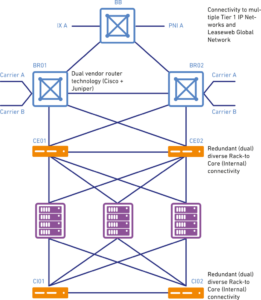This article describes the available network types for the Leaseweb services.
Network types
Leaseweb offers two network choices for your server—Premium and Volume, each with its own strong points.
Both Volume and Premium have the same network architecture and are fully redundant.

Depending on the service you’re hosting, this article can help you decide which one is most suitable.
Premium network
The Premium package uses a full mix of Tier 1 Transit providers and peering, using a quality-optimised routing approach and allowing customers to request routing adjustments to specific networks.
This delivers superior service availability (uptime), latency (speed), packet loss (quality) and flexibility.
The Premium package comes with an improved Service Level agreement (SLA) for Network Availability. For more information, please refer to our Legal page (Support and Service Level Schedule – Chapter D).
Use case: applications and services that need high performance (uptime, low latency, low packet loss) – e.g. gaming, AdTech/MarTech, (broadcast quality) video, etc.
Volume network
The Volume type may use a limited mix of Transit providers and peering and routes Internet traffic in a best effort approach, using a cost-optimised standard traffic routing (actual routing depends on the location).
Use case: applications and services with less stringent performance requirements (e.g. back-up service).
Availability matrix
| Service | Premium Network | Volume Network | Bandwidth / Datatraffic Aggregation |
|---|---|---|---|
| Dedicated Server | ✅ | ✅ | ✅ |
| Dedicated rack | ✅ | ✅ | ✅ |
| VPS | ❌ | ✅ | ❌ |
| Public Cloud | ❌ | ✅ | ❌ |
| Elastic Compute OnDemand | ❌ | ✅ | ❌ |
| Elastic Compute Reserved | ✅ | ✅ | ❌ |
| Colocation unit | ✅ | ✅ | ✅ |
| Colocation rack | ✅ | ✅ | ✅ |
| VMware vCloud | ✅ | ✅ | ✅ |
| VMware vSphere Single Tenant & HCI | ✅ | ✅ | ✅ |
| Managed Kubernetes | ❌ | ✅ | ❌ |
Capacity
Leaseweb offers a variety of uplink capacity and bandwidth options, ranging from 100Mbps to multiple 100Gbps ports.
More information
- More information regarding billing and surcharges can be found in this KB article: metering and billing
- Leaseweb’s hosting network on Leaseweb.com
- Leaseweb Service Status
- Leaseweb peering networks view on peeringdb.com